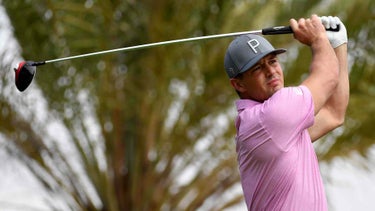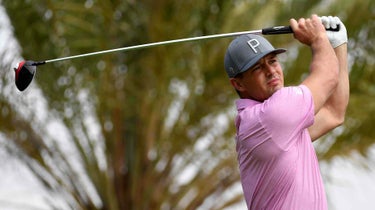Stewart Cink shot a 7-under 64 on Thursday to take a three-stroke lead after the first round of the Charles Schwab Cup Championship.
‘It’s a feat of engineering’: How Bryson DeChambeau’s Ping irons came to life | Wall-to-Wall Equipment

The latest edition of GOLF’s weekly equipment notes details Bryson DeChambeau’s custom Ping irons and wedges.
The post ‘It’s a feat of engineering’: How Bryson DeChambeau’s Ping irons came to life | Wall-to-Wall Equipment appeared first on Golf.
The latest edition of GOLF’s weekly equipment notes details Bryson DeChambeau’s custom Ping irons and wedges.
The post ‘It’s a feat of engineering’: How Bryson DeChambeau’s Ping irons came to life | Wall-to-Wall Equipment appeared first on Golf.
Welcome to Wall-to-Wall Equipment, the Monday morning gear wrap-up in which GOLF equipment editor Jonathan Wall takes you through the latest trends, rumors and breaking news.
It’s been a busy few weeks for Bryson DeChambeau on the equipment front. Shortly after his deal with Cobra Golf dissolved in early February, the 29-year-old made the trek to Phoenix to spend time inside Ping’s “F.O.C.A.L room” — the acronym stands for “Fast Optical Capture Analysis Lab” — an indoor hitting bay situated a short walk from Ping’s Proving Grounds that’s loaded with high-speed motion-capture cameras.
For DeChambeau, a big reason for the trip was to test his current equipment setup on the high-speed camera system to gather closure rates and shaft deflection ahead of LIV’s first event of the season. The other part of the equation was testing Ping equipment to determine if there was anything in the current lineup worth pursuing.
Of course, when you’re playing single-length irons — as is the case with DeChambeau — creating a custom set to test takes time. Working alongside Ping Tour rep Spencer Rothluebber, DeChambeau described the profile and performance characteristics he was looking for in a set of irons during an initial concept meeting. The meeting eventually turned into the jumping-off point for a set of custom Ping i230 irons and Glide 4.0 wedges he put in play last week in Mexico.
“From our conversations, he just wanted to be able to turn everything over,” Rothluebber told GOLF.com. “He wasn’t too picky with the [iron] model, so we figured the i230 shape and size aligned with what he was trying to accomplish.”
Instead of building DeChambeau a set of completely custom clubs, Ping engineers made modifications to a set of off-the-rack i230 heads, beginning with heavy grinding to the toe section to help induce a draw at ground impact. The modification turned out to be the most painless part of the process. Where things became slightly more complicated was when Rothluebber measured the overall weight of each of DeChambeau’s clubs.
Most golfers tend to focus on swing weight to establish a constant feel throughout the set — but not DeChambeau. Instead, he prefers to target a specific total weight that includes the head, shaft and grip.
“The more and more I’ve learned about him, he’s not swing-weight oriented but rather total weight,” said Rothluebber. “So his clubs were roughly 516 grams, swing-weighted B9 to C1. For him, it’s about establishing a weight baseline. He likes to feel it’s the same across the board.”
Realizing they’d need to find a similar weight throughout the set, Ping targeted a head weight of 275 grams from the i230 4-iron through the Glide 4.0 lob wedge. A 275-gram head weight is easy to achieve when you’re dealing with an 8-iron, but the overall head weight usually decreases at the top of the set where a 3-iron head might weigh 228 grams.
With the help of Ping’s engineering department, the group was able to bump up the iron head weight in a significant way by utilizing the existing toe and tip weight ports found inside i230, along with a lesser-known elastomer weight situated in the cavity. According to Rothluebber, the silver strip of elastomer found in the cavity weighs 3 grams in the retail head. To get the head weight up to 275 grams, Ping’s injection mold shop replaced the elastomer with a completely custom 25-gram strip to achieve a constant head weight.
“It took a day to figure out the injection molding, plus the gram weights and grinds we needed,” Rothluebber said. “But once we managed to get those questions answered, we had a set done at 37.5 inches across the board in six hours. Each club is within 1 gram of 521 grams. Also, because of the center of gravity, the swing weight changes. So the longer the blade length gets, the longer the CG droops, essentially. So that’s why even though they all weigh the same, the swing weight on the 4-iron is at C4 and the wedge is at C2. Even though they’re all the same length and lie angle (66.5 degrees).”
With a constant weight established, Ping sought to solve two more pressing issues: loft and bounce. Due to how DeChambeau delivers the club, his 4-iron has a stated loft of 16 degrees; the stock Ping i230 comes in at 22.5 degrees. Simply put, bending the iron 6.5 degrees strong wasn’t an option. Bending an iron more than 2 degrees not only compromises turf interaction but how the head looks visually at address. This is where things got really interesting.
“What’s going to make the set look good at address — and functional?” he said. “That was the most important question that needed an answer. To get lofts where they needed to be, we had to grind different heads to ensure bounce was consistent across the board. When we selected a club to use for each iron in his set, we sought out a club that would provide the right amount of bounce and visuals at address. When you’re bending something that strong, you’re creating more offset. That’s why we used a 3-iron to get there on, say, the 4-iron instead of bending a 4-iron head to get the loft Bryson needed.”
(Here’s a look at Bryson’s i230 irons specs, and the iron head used for each build:)
4-iron: 16 degrees (3-iron head)
5-iron: 19.5 degrees (4-iron)
6-iron: 21.5 degrees (4-iron)
7-iron: 25 degrees (5-iron)
8-iron: 30 degrees (7-iron)
9-iron: 35 degrees (8-iron)
PW: 40 degrees (9-iron)
In the end, Ping was able to create a set with low bounce in the long irons and more bounce in the mid and short irons to mimic a variable-length set.
Along with the irons, DeChambeau had a set of Glide 4.0 wedges built at the same 275-gram head weight. Only instead of having to add weight, Ping had to do the opposite, using a wide sole 58-degree to make the lob wedge by bending it weak to add bounce. From there, material was shaved off to get each head down to the 275 number.
“Hands down it was the most technical set I’ve ever worked on,” said Rothluebber. “I remember leaving after the day thinking, wow, we just did that. In my opinion, it’s a feat of engineering for our team that we have the ability to build Bryson a set from a model you can go buy off the rack. We spend time on it and are able to build a one-length set. We’re not promoting one-length irons, but it’s something that shows we can make it happen.”
Even more impressive was that Ping somehow managed to take the set from concept to final product in a matter of a few days, with the actual build taking a day to complete. Bryson’s clubs are a reminder that Ping has some extremely brilliant minds housed inside the walls at HQ that know how to solve even the most tedious (and technical) equipment questions.
Want to overhaul your bag for 2023? Find a fitting location near you at GOLF’s affiliate company True Spec Golf. For more on the latest gear news and information, check out our latest Fully Equipped podcast below.
The post ‘It’s a feat of engineering’: How Bryson DeChambeau’s Ping irons came to life | Wall-to-Wall Equipment appeared first on Golf.

